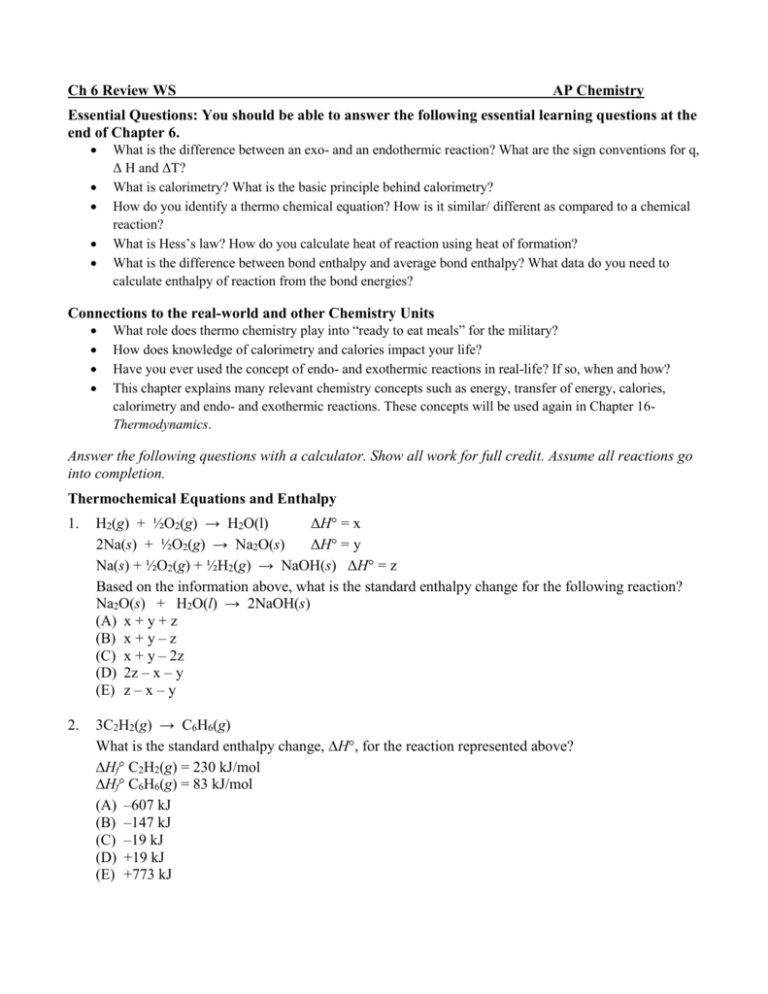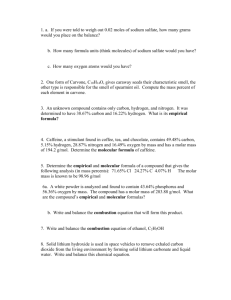Ch 6 Review WS AP Chemistry
advertisement

Ch 6 Review WS AP Chemistry Essential Questions: You should be able to answer the following essential learning questions at the end of Chapter 6. What is the difference between an exo- and an endothermic reaction? What are the sign conventions for q, Δ H and ΔT? What is calorimetry? What is the basic principle behind calorimetry? How do you identify a thermo chemical equation? How is it similar/ different as compared to a chemical reaction? What is Hess’s law? How do you calculate heat of reaction using heat of formation? What is the difference between bond enthalpy and average bond enthalpy? What data do you need to calculate enthalpy of reaction from the bond energies? Connections to the real-world and other Chemistry Units What role does thermo chemistry play into “ready to eat meals” for the military? How does knowledge of calorimetry and calories impact your life? Have you ever used the concept of endo- and exothermic reactions in real-life? If so, when and how? This chapter explains many relevant chemistry concepts such as energy, transfer of energy, calories, calorimetry and endo- and exothermic reactions. These concepts will be used again in Chapter 16Thermodynamics. Answer the following questions with a calculator. Show all work for full credit. Assume all reactions go into completion. Thermochemical Equations and Enthalpy 1. H2(g) + ½O2(g) → H2O(l) ΔH° = x 2Na(s) + ½O2(g) → Na2O(s) ΔH° = y Na(s) + ½O2(g) + ½H2(g) → NaOH(s) ΔH° = z Based on the information above, what is the standard enthalpy change for the following reaction? Na2O(s) + H2O(l) → 2NaOH(s) (A) x + y + z (B) x + y – z (C) x + y – 2z (D) 2z – x – y (E) z – x – y 2. 3C2H2(g) → C6H6(g) What is the standard enthalpy change, ∆H°, for the reaction represented above? ∆Hf° C2H2(g) = 230 kJ/mol ∆Hf° C6H6(g) = 83 kJ/mol (A) –607 kJ (B) –147 kJ (C) –19 kJ (D) +19 kJ (E) +773 kJ 3. The reaction of quicklime (CaO) with water produces slaked lime [Ca(OH)2], a substance widely used in the construction industry to make mortar and plaster. The reaction of quicklime and water is highly exothermic. CaO(s) + H2O(l) ---> Ca(OH)2(s) ΔHrxn = -350 kJ/mol (A) What is the heat of reaction per gram of calcium oxide (CaO) reacted? (B) How much heat in kilojoules, is associated with the production of 50.0 kg of slaked lime? (C) If 10.0 g CaO is added to 100.0 g H2O at 25 °C in an insulated container, will the temperature of the resulting mixture reach the boiling point of water? [Use a value of 1.09 J/g-°C for the specific heat of Ca(OH)2(s).] Hess’ Law 4. Use Hess’ Law to calculate ∆H° for the following reaction: 4HCN(l) + 9O2(g) → 4CO2(g) + 4NO2(g) + 2H2O(g) Given: H2(g) + 2C(s) + N2(g) → 2HCN(l) ∆H° = +217.8 kJ C(s) + O2(g) → CO2(g) ∆H° = –393.5 kJ 2NO2(g) → N2(g) + 2O2(g) ∆H° = –66.40 kJ 2H2(g) + O2(g) → 2H2O(g) ∆H° = –483.6 kJ 5. Calculate ∆Hf° of nitromethane, CH3NO2, given the following information: 4CH3NO2(l) + 3O2(g) → 4CO2(g) + 6H2O(g) + 2N2(g); ∆H° = –3472.8 kJ C(s) + O2(g) → CO2(g); ∆H° = –393.5 kJ 2H2(g) + O2(g) → 2H2O(g); ∆H° = –483.6 kJ Calorimetry 6. 0.500g of magnesium chips are placed in a coffee-cup calorimeter and 100.0 ml of 1.00 M HCl is added to it. The reaction that occurs is: Mg (s) + 2HCl (aq) H2 (g) + MgCl2 (aq) The temperature of the solution increases from 22.2oC (295.4 K) to 44.8 oC (318.0 K). What’s the enthalpy change for the reaction, per mole of Mg? (Assume specific heat capacity of solution is 4.20 J/(g * K) and the density of the HCl solution is 1.00 g/ml.) 7. 200. ml of 0.400 M HCl is mixed with the same amount and molarity of NaOH solution, inside a coffee-cup calorimeter. The temperature of the solutions before mixing was 25.10 oC, and 27.78 oC after mixing and letting the reaction occur. Find the molar enthalpy of the neutralization of the acid, assuming the densities of all solutions are 1.00 g/ml and their specific heat capacities are 4.20 J/(g * K). 8. You are working for a fancy laboratory, and your boss has asked to you perform a calorimetry investigation to determine the heat of neutralization when hydrochloric acid and sodium hydroxide are mixed. a. Write the complete, balanced molecular equation for the reaction between hydrochloric acid and sodium hydroxide. b. Write the balanced net ionic equation for this reaction. c. You measure 50.00mL of each 0.10M solution, put them in separate containers, and let them sit for several minutes. You record the initial temperature for each solution and then mix them in a coffee cup calorimeter. You record the temperature during the entire process. Assuming that the acid and base solutions have the same density and specific heat as water, explain HOW you would calculate the heat produced during the procedure. (You CANNOT actually calculate anything. Simply explain your plan of attack.) d. Congratulations! The computer is ready to give you the data for your experiment. The solutions started at 23.5°C and the highest recorded temperature was 29.6°C. The density of water is 1.00g/mL and the specific heat of water is 4.20 J/g K. Assuming all of the energy from the reaction went into the solution, how much heat was produced during the procedure? e. Use the net ionic equation from #2 to calculate the number of moles of product formed during this reaction. f. What is the heat of neutralization (ΔH) per mole for this reaction? Your boss is impressed by your work, but would like to you to complete a follow up experiment. She wants you to find the heat of neutralization of nitric acid and potassium hydroxide using the exact same amounts and same concentrations as you did before. g. Write the complete, balanced molecular equation for the reaction between nitric acid and potassium hydroxide. h. Write the net ionic equation for this reaction. i. Given you are using the exact same amounts and concentrations as you did in your first experiment, predict how the calculated value of heat of reaction will compare to the answer you found in #8. Explain your prediction. j. Oh no! Your experiment was going so well, but then you realized you had set up your calorimeter incorrectly and a significant amount of heat was lost into the air during this experiment. What effect does this error have on your calculated vale of ΔH? Justify your answer. Specific Heat 9. A mass of 130. g of a metal is heated to 135 °C and placed in 250. mL of water at 21.3°C. If the final temperature of the water is 45.8 °C, calculate the specific heat of the metal in J/(°C-g). 10. 84.12 g of gold at 120.1 °C is placed in 106.4 g of water at 21.4 °C. At what temperature will the gold and the water reach thermal equilibrium? CAu = 0.129 J/(°C-g); CH2O = 4.184 J/(°C-g) 1. Ans: D 2. Ans: A 3. a. Ans: -6.24 kJ/g CaO; b. Ans: -2.36 x 105 kJ; c. Ans: Yes 4. Ans: ΔHf -2360 kJ 5. Ans: ΔHf = 112 kJ/mol 6. Ans. -4.64 x 105 J/mol Mg 7. Ans. -56.3 kJ/mol 8. a. Ans: HCl + NaOH NaCl + H2O; b. Ans: H+ + OH- H2O; c Ans: -take initial temp of each solution - take final temp and mass Qrxn + qsolution = 0 Qrxn + (msolution x csolution x (Tfinal – Tinitial)) = 0 d. Ans: Q= mcΔT = (100g x 4.20g/gC x 6.1 C) = 2562 J e. Ans: Moles = 0.05 L x 0.10 M = 0.005 moles H+ = 0.005 moles product f. Ans: 0.005 moles 2,562 J; 1 mol 512.4 kJ/mol g. KOH + HNO3 KNO3 + H2O h. H+ + OH- H2O i. Same; same temp change by same # of moles same heat of neutralization j. ΔH lower because you lost part of heat to surroundings. 9. Ans: 2.21 J/K-g 10. Ans: 23.8°C 5







